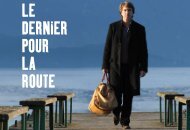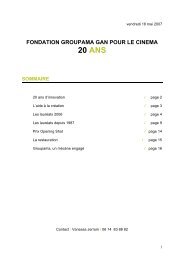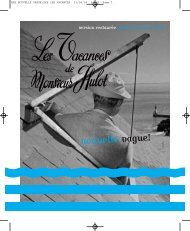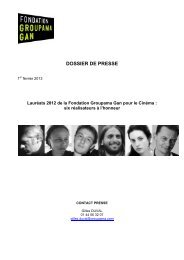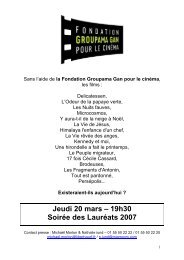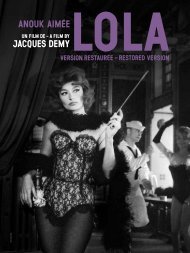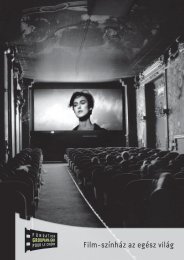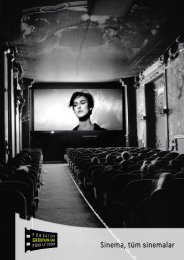duVoyage - Fondation Groupama Gan pour le Cinéma
duVoyage - Fondation Groupama Gan pour le Cinéma
duVoyage - Fondation Groupama Gan pour le Cinéma
You also want an ePaper? Increase the reach of your titles
YUMPU automatically turns print PDFs into web optimized ePapers that Google loves.
Note that in 1944, Jehanne d’Alcy had this to say: “We had to make two exits that even trams could pass<br />
through. Méliès had cars and theatre troupes go through. He made Joan of Arc in there.”<br />
“The width of the studio now being more than 13 metres, a large two-storey building was built behind it, to<br />
replace the smal<strong>le</strong>r one; the ground floor had the ladies’ dressing rooms, and the first floor, the men’s dressing<br />
rooms; two large case-loads of set decorations were housed in the ‘annexes’, on the right and <strong>le</strong>ft of the<br />
stage, then we built a large hangar, adjacent to the studio and of the same size, with an asphalt floor, but<br />
made up of iron frames supporting a canvas roof and shutters on the side, and enabling the room to be comp<strong>le</strong>tely<br />
closed as often as necessary (sheltered from the sun and the rain), or to serve as a simp<strong>le</strong> empty space<br />
in the day, with the shutters up so as not to block light into the studio when filming was taking place.<br />
This new construction served generally to paint scenery and carpentry in the summer, to avoid the torrid heat<br />
of the studio. From time to time, it was transformed into a large tent where a great number of actors could dress.<br />
“Finally (...)”, continues Noverre, “a new small room was built behind the one that stored the camera, so that<br />
it be possib<strong>le</strong> to move this back even further and enab<strong>le</strong> 11 metres wide shots. Modifications were made continually,<br />
in successive waves, driven by changing needs so that this first studio ended up having a strange te<strong>le</strong>scopic<br />
appearance. Soon construction started around the studio. First, an enormous hangar which served as<br />
storage space for heavy equipment (on set Méliès used balls, entire trains, trams, cruise ships, climbing frames<br />
and stairs of all kinds, airplanes, etc. Everything having been built and stored in his workshops). Then a large<br />
building with three floors, the ground floor of which became the wood store-room, and the two other floors<br />
for customers; this building was made entirely of brick, ciment and iron, and had no wood, to reduce the risk<br />
of a fire. Over 20,000 costumes of all kinds and from all eras, with their accessories, underwear, shoes, arms,<br />
wigs, buff<strong>le</strong>teries, gloves, jewel<strong>le</strong>ry, etc....were kept here.”<br />
Maurice Noverre, «The work of Georges Méliès. A retrospective study of the first “cinematographic studio”<br />
designed for theatrical film-making», Le Nouvel Art cinématographique, 2 e série, n°3, Brest, juil<strong>le</strong>t 1929, p.64-83<br />
Workshop B<br />
A second workshop, known as workshop B, was built at the end of 1907 to meet market requirements, particularly<br />
that of America, again on the Montreuil property. From then on, Méliès could work on two films in<br />
paral<strong>le</strong>l.<br />
The workshop was a structure made of glass and steel, built on a brick foundation. The studio was extremely<br />
well-equipped: Méliès had arc lamps instal<strong>le</strong>d together with mercury va<strong>pour</strong> tubes which if “satisfactorily<br />
combined’’ would allow the use of artificial light “together with natural light” (e<strong>le</strong>ctricity was instal<strong>le</strong>d in<br />
workshop A around 1902), and a crane enab<strong>le</strong>d peop<strong>le</strong> and objects to be lifted up onto the stage.<br />
In 1914, when he was already ruined financially, Méliès transformed workshop B into a local cinema. During<br />
the war, the space was used for concerts, before being renamed the Théâtre des Variétés artistiques, inaugurated<br />
in October 1917.<br />
In 1923, what used to be workshop B was demolished in just one month.<br />
Shortly after the second world war, workshop A was also destroyed.<br />
Between 1896 and 1912, around 520 films were shot in Montreuil-sous-Bois.<br />
The theatre company<br />
“His troupe? A real café-concert crowd!”<br />
Strictly speaking there was no Star Film theatre troupe. Georges Méliès simply composed the troupe he needed<br />
depending on what was required for his films. Sometimes there were principal characters and extras, so-<br />
164<br />
metimes numbering several dozen. They were a happy mix of Méliès’ close friends and family, neighbours<br />
and theatre actors. As the years passed, more and more often the latter took the place of the former. For examp<strong>le</strong>,<br />
Louvel, Méliès’ gardiner, appeared in the first ever camera test films, burning <strong>le</strong>aves, and the family, Octavia<br />
Hunier, featured in Une partie de cartes (“A Game of Cards”), Méliès’ first film dating back to 1896. Here again<br />
there were family members, such as Georges’ son, André (Un locataire diabolique), his daughter Georgette (Un<br />
bon petit diab<strong>le</strong>), a cousin, Paul (Le Sacré d’Edouard VII). There were also neighbourhood friends and acquaintances.<br />
“When he needed actors, he invited all the staff, friends, parents and neighbours,” commented the operator<br />
Maruice Astaix to the Commission for historical research.<br />
However, Méliès knew that only professional actors would be ab<strong>le</strong> to act with sufficient grace and ease in the<br />
ro<strong>le</strong>s he imagined. At the time, there were many actors to be found at the Châte<strong>le</strong>t theatre, or even the Folies<br />
Bergères. Méliès did not intend to hire the stars of the day (they in any case would only accept cinema work<br />
much later, around 1908, and then anonymously). No, what Georges Méliès was looking for were ordinary actors<br />
capab<strong>le</strong> of making his special effects work, and who could dance and move whi<strong>le</strong> playing their parts.<br />
His links to the world of Parisian shows proved extremely useful. He recruited from the theatre and musichall.<br />
B<strong>le</strong>uette Bemon, who was singing at L’Enfer cabaret when Méliès spotted her, would play in 1899 in Cendrillon<br />
(“Cinderella”) whi<strong>le</strong> continuing her career at the Eldorado. It was she who played “the woman in the<br />
crescent moon”, in A Trip to the Moon.<br />
He gradually built a core troupe as his career progressed: Jeanne Calvière, a stab<strong>le</strong>woman at the Cirque d’Hiver<br />
(Winter Circus), at the Trianon Lyric theatre, was hired on the production of Jeanne d’Arc (1900), and would remain<br />
part of his troupe for several years.<br />
As for the actor André Deed, Méliès would claim that he was the only actor capab<strong>le</strong> of appreciating the subt<strong>le</strong>ty<br />
of his special effects and the finesse of execution required to produce them. Paul Gilson commented: “His<br />
troupe? Neighbours, helpers, eccentric wind-bags, rol<strong>le</strong>r skaters, Litt<strong>le</strong> Tich, acrobats from the Folies Bergères,<br />
the Ping-Pong Girls, dancers from the Moulin-Rouge, Loïe Ful<strong>le</strong>r, Fragson, Mamzel<strong>le</strong> Zizi Papillon...a real caféconcert<br />
crowd ».<br />
If to begin with Méliès himself recruited his actors and extras, very quickly he became known around Paris,<br />
and was sought out in his office at the theatre. Confronted with the large number of candidates, he de<strong>le</strong>gated<br />
hiring actors and extras to his close friends and family. For Cendrillon, where a large number of extras was required,<br />
he even employed a Chief Extra.<br />
The case of Jehanne d’Alcy was unique. Not only because she became Méliès’ second wife, but because she was one<br />
of the very first actresses to <strong>le</strong>ave the theatre (where she had become quite famous by 1896), with the intention of<br />
devoting herself entirely to cinema. She would feature in Méliès’ films until her physical appearance prevented<br />
her from doing so, and then took care of costumes.<br />
Compared to others (Pathé and Gaumont in particular), Méliès paid his actors well: one golden Louis a day, plus<br />
lunch. Peop<strong>le</strong> were hired the day before, for the following day. And when filming was sometimes impossib<strong>le</strong><br />
due to lack of sunlight, Méliès still paid his actors.<br />
Méliès’ operators<br />
Méliès operators enjoyed much more stab<strong>le</strong> employment, than say, the Lumière’s: they did not travel, were guaranteed<br />
a salary and did not rely on a projection’s success for their earnings. Nonethe<strong>le</strong>ss, they were required<br />
to carry out various tasks that went beyond their operator ro<strong>le</strong>. Thus, Lec<strong>le</strong>rc, then François Lal<strong>le</strong>ment,<br />
Maurice Astaix and Théophi<strong>le</strong> Michault all developed film, and contributed to setting up scenery. Sometimes,<br />
they even doub<strong>le</strong>d as actors: Lal<strong>le</strong>ment played the Marine officer, for examp<strong>le</strong>, in A Trip to the Moon.<br />
The ro<strong>le</strong> of operator was highly valued by Méliès. In fact, in addition to regularly turning the camera hand<strong>le</strong><br />
(to avoid the picture moving from top to bottom in particular) or the ability to manipulate the speed of the<br />
moving film (which had to be acce<strong>le</strong>rated during batt<strong>le</strong> scenes and slowed down during cloud-filming), Méliès’<br />
165



